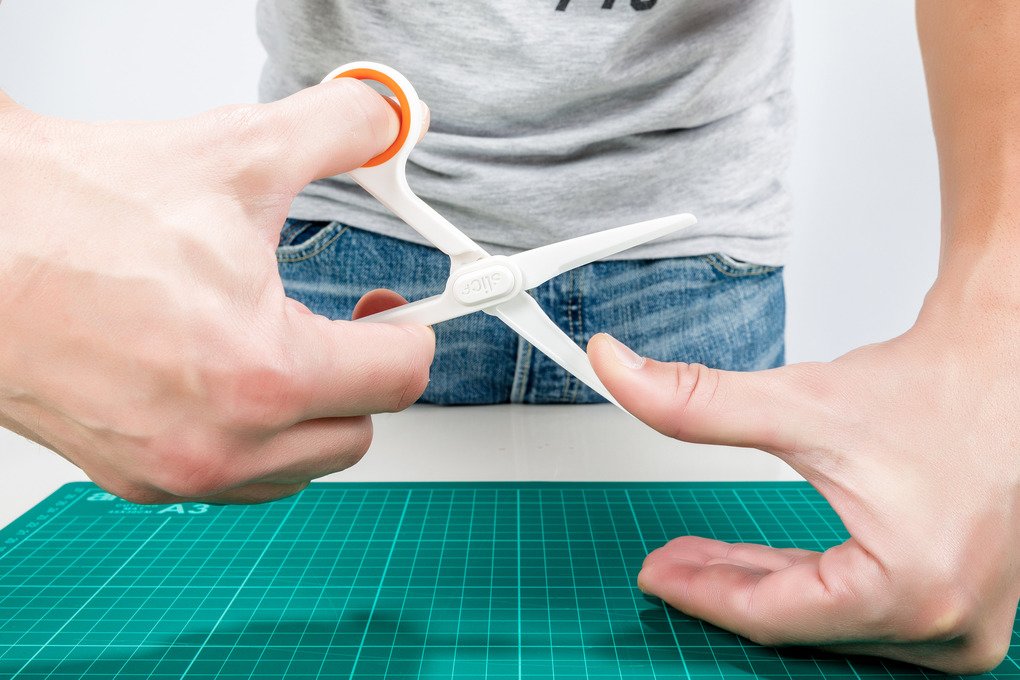Lab Scissors: How Slice Scissors Bring Safety to the Lab

Although Slice® safety scissors were not designed exclusively for use as lab scissors, their features make them excellent in lab settings. Created using a patent-pending double-angle grind on 100-percent zirconium oxide, our finger-friendly® blade edges are safe to the touch. Why does that matter for you?
Cutting your finger with sharp metal-bladed scissors at home can be painful and limit your ability to function while your wound heals. In an industrial setting, such a cut is not only debilitating, but it can hurt your company’s safety record and bottom line. Cuts sustained in a lab setting pose additional risks.
Laboratory Scissors
If a laceration or puncture wound occurs, scissors for lab use pose an additional hazard: contamination with biological materials or harsh chemicals. Contamination can have long-ranging consequences, anywhere from chemical burns to life-threatening infections. All the more reason to find a safer alternative to traditional metal laboratory tools. Slice makes a complete line of safety scissors, as demonstrated in this video:
Slice safety scissors are useful as lab scissors, too.
With a little creativity and a willingness to experiment, you may find that one or more of these scissor models works well in your laboratory for cutting sutures, gauze, and tubing, for removing packing materials from lab material shipments, or for tissue dissection. Another distinct advantage of using our scissors for lab work is that they maintain their sharpness 11 times longer than comparable metal blades. This means that you’ll spend less money on periodic replacement of laboratory tools.
Unlike metal scissors, our scissors never rust. This can be especially critical when working with blood samples to perform blood typing, cross-matching, and screening processes. Rust creates pits in the metal that can retain microscopic residue of prior blood samples, even after the instrument has been cleaned. This results in an increased potential for cross-contamination of blood samples, invalidating results. Slice ceramic scissors are made from 100-percent zirconium oxide, an material that is:
- Non-sparking
- Non-conductive
- Non-magnetic
- Chemically inert
Not only do our safety blades never rust, thus making them ideal for blood sample work, but also they’re very easy to clean. The same engineered ceramics used in our knife blades are used in our scissors. Cleaning these ceramics is easy, as discussed here:
Safe and easy cleanup of Slice scissors used as lab scissors.
Scissor Dissection
Scissors are often used in surface tissue dissection in gross anatomy labs, classrooms, morgues, and medical examiner or coroner offices. Although a scalpel is often the preferred instrument (because scissors do crush tissue during cutting) the scissor blades offer important features: stabilizing the tissue, providing cut depth and direction control, improving cut accuracy, allowing controlled push cutting, enabling efficient blunt dissection, and providing a mechanical advantage when cutting tough or thick tissues.
Although Slice scissors are not ideal instruments for tough- or thick-tissue scissor dissection, such as through human skin, their sharpness and durability make them useful additions to your lab.
One of the problems with laboratory scissors is that metal dulls quickly if the scissors are being used to cut tissue. For this reason, a pair of general purpose scissors is often used with the intent of replacing them frequently. This reserves the more expensive scissors for scissor dissection, where their sharpness is required. Slice ceramic scissors will maintain their edge 11 times longer than metal scissors. For that reason, they’re very cost effective general purpose scissors for lab work.
Another problem with typical lab scissors is that left-handed workers must adapt to using scissors with their right hand, unless the lab is willing to invest in a specific set of laboratory tools for left-handed people. Slice solves this problem, as our safety scissors are designed to be used ambidextrously.
In laboratory dissection work, scissors are used with specific hand-position grips, such as the wide-based tripod grip, where the thumb and the ring finger are placed in the finger rings. This grip can be very uncomfortable, unless the hand position is rigorously maintained. Slice 10544 small scissors and 10546 pointed-tip scissors can be used with a wide-based tripod grip and they have soft-touch rubberized finger grips that lessen hand strain and discomfort.
The 10544 Ceramic Scissors (Small) are suitable for “push cutting,” where the cut begins with the scissor blades partially closed, although the tip is open. This longer cut is made by pushing the closed blade forward in one continuous motion without opening or closing the scissors. This technique can be used to cut bench paper or thinner animal tissues.
The 10546 pointed-tip scissors are suited to “blunt dissection” of smaller specimens, such as frogs or small mammals. In this case, the scissors enter the tissue in a closed position and are then opened, thereby separating fine tissue attachments.
What Makes Slice Scissors Safer?
Our safety scissors bring to safety scissors the same proprietary finger-friendly grind we use on our knife and box cutter blades. As a result, these scissors are very effective at cutting different types of materials, while at the same time being safe to touch. The zirconium oxide material that we use for our scissor blades contributes to their longevity and cutting performance, but it is really our patent-pending double-angle grind that makes them safe to the touch.

Slice scissor blades last 11 times longer than steel blades. Our glass-filled nylon handles are lightweight, with rubberized soft-touch linings on the finger grips. Our commitment to using high-quality materials, coupled with superior design, ensures that you will have a long-lasting, durable pair of scissors.
With different blade configurations and tip options, our ceramic scissors could be useful in a variety of microscopy, sample preparation, laboratory, and dissection applications. No matter which pair of our scissors you choose as your lab scissors, rest assured that you’re making an investment in quality and safety.
More Information:
- All about Slice safety scissors.
- How to clean Slice blades.
